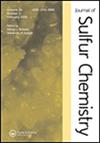用DFT与people、Dunning和Karlsruhe基集配对预测亚砜键解离焓
IF 1.6
3区 化学
Q3 CHEMISTRY, MULTIDISCIPLINARY
引用次数: 0
摘要
通过计算分析确定了8个分子中S-O键的键解离焓(BDEs),并将其与实验得到的BDEs进行了比较。计算bde是利用密度泛函理论(DFT)泛函与基集分类的各种组合来确定的。其中,M06-2X、mPW1LYP、ωB97X-D3、PBE0、B3P86等DFT方法分别与def2-TZVP/J、def2-TZVP、aug-cc-pV(T + d)Z、6-311 + G(2df,2p)、def2-QZVP等基集配对。通过图形表示、屈服斜率、决定系数(R2)和均方根误差(RMSE)指标来评估计算bde与实验bde的比较。此外,将比较分析扩展到包括完整基集方法(CBS-QB3和CBS-4M),它们在预测实验确定的S-O BDEs方面的准确性相对较低。在所有测试的方法中,B3P86/aug-cc-pV(T + d)Z和B3P86/def2-QZVP方法被推荐用于亚砜bde的计算预测。本文章由计算机程序翻译,如有差异,请以英文原文为准。
Sulfoxide bond dissociation enthalpies predicted by DFT paired with Pople, Dunning, and Karlsruhe basis sets
Computational analysis was conducted to determine the bond dissociation enthalpies (BDEs) of S–O bonds in eight molecules, which were subsequently compared to their experimentally derived BDEs. Computational BDEs were determined utilizing various combinations of density functional theory (DFT) functionals with an assortment of basis sets. Specifically, DFT methods including M06-2X, mPW1LYP, ωB97X-D3, PBE0, and B3P86 were paired with basis sets def2-TZVP/J, def2-TZVP, aug-cc-pV(T + d)Z, 6-311 + G(2df,2p), and def2-QZVP. The comparison between computational and experimental BDEs was evaluated through graphical representation, yielding slope, coefficient of determination (R2), and root mean square error (RMSE) metrics. Additionally, comparative analyses were expanded to include complete basis set methods (CBS-QB3 and CBS-4M), which exhibited comparatively lower accuracy in predicting experimentally determined S–O BDEs than the DFT methods. Among all methods tested, the B3P86/aug-cc-pV(T + d)Z and B3P86/def2-QZVP methods are recommended for computational prediction of BDEs for sulfoxides.
求助全文
通过发布文献求助,成功后即可免费获取论文全文。
去求助
来源期刊

Journal of Sulfur Chemistry
CHEMISTRY, MULTIDISCIPLINARY-
CiteScore
4.10
自引率
9.10%
发文量
38
审稿时长
6-12 weeks
期刊介绍:
The Journal of Sulfur Chemistry is an international journal for the dissemination of scientific results in the rapidly expanding realm of sulfur chemistry. The journal publishes high quality reviews, full papers and communications in the following areas: organic and inorganic chemistry, industrial chemistry, materials and polymer chemistry, biological chemistry and interdisciplinary studies directly related to sulfur science.
Papers outlining theoretical, physical, mechanistic or synthetic studies pertaining to sulfur chemistry are welcome. Hence the target audience is made up of academic and industrial chemists with peripheral or focused interests in sulfur chemistry. Manuscripts that truly define the aims of the journal include, but are not limited to, those that offer: a) innovative use of sulfur reagents; b) new synthetic approaches to sulfur-containing biomolecules, materials or organic and organometallic compounds; c) theoretical and physical studies that facilitate the understanding of sulfur structure, bonding or reactivity; d) catalytic, selective, synthetically useful or noteworthy transformations of sulfur containing molecules; e) industrial applications of sulfur chemistry; f) unique sulfur atom or molecule involvement in interfacial phenomena; g) descriptions of solid phase or combinatorial methods involving sulfur containing substrates. Submissions pertaining to related atoms such as selenium and tellurium are also welcome. Articles offering routine heterocycle formation through established reactions of sulfur containing substrates are outside the scope of the journal.
 求助内容:
求助内容: 应助结果提醒方式:
应助结果提醒方式:


